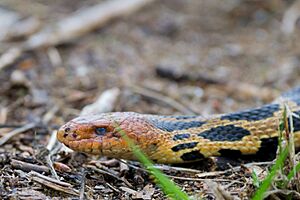Eastern fox snake facts for kids
Quick facts for kids Pantherophis vulpinus |
|
|---|---|
 |
|
| Conservation status | |
| Scientific classification | |
| Genus: |
Pantherophis
|
| Species: |
vulpinus
|
| Synonyms | |
|
|
The foxsnake, also known as the eastern fox snake, is a type of snake found in North America. Its scientific name is Pantherophis vulpinus. These snakes are not venomous, meaning they are not dangerous to humans. They belong to a group of snakes called rat snakes.
Contents
About Foxsnakes
Foxsnakes are known for their unique smell. When they feel threatened, they can release a musky scent. This smell is a lot like what a fox smells like. That's how they got their common name!
What's in a Name?
The scientific name vulpinus means "fox-like." This name was given to honor a person named Rev. Charles Fox. Another name sometimes used, gloydi, honors an American snake expert, Howard K. Gloyd.
Eastern vs. Western Foxsnakes
For a while, scientists thought there were two main types of foxsnakes. One was called the western foxsnake and the other the eastern foxsnake. Now, scientists usually say that the Mississippi River helps divide them.
- Snakes east of the Mississippi River are generally called Pantherophis vulpinus, or the eastern foxsnake.
- Snakes west of the Mississippi River are called Pantherophis ramspotti, or the western foxsnake.
So, the name "eastern foxsnake" now includes snakes that were once called "western foxsnake." It can be a bit confusing!
How to Spot a Foxsnake
Adult foxsnakes can grow to be about 3 to 6 feet (1 to 2 meters) long. They have a short, flat nose. Their bodies are usually a light golden-brown color with dark brown spots. If you look at their belly, you'll see a yellow pattern that looks like a checkerboard.
Where They Live
Eastern foxsnakes (P. vulpinus) are found in the upper midwestern United States. They live mostly to the east of the Mississippi River.
You can find them in places like Michigan and Ohio in the U.S. They also live in Western Ontario, Canada. In Michigan, some people call the foxsnakes in the Upper Peninsula "pine snakes."
Their Homes
Foxsnakes like to live in many different kinds of places. They can be found in:
- Open woodlands
- Prairies (grassy areas)
- Farmland
- Pastures (fields where animals graze)
- Marshlands (wet, grassy areas)
Foxsnake Habits
Foxsnakes are strong and quick. They are good at climbing trees, but you'll usually find them on the ground. They are active during the day, meaning they hunt and move around when the sun is out. However, if it's very hot in the summer, they might hunt at night.
Like all snakes, foxsnakes are cold-blooded. This means their body temperature changes with their surroundings. To stay safe from extreme heat or cold, they often hide in burrows or under logs and rocks. In winter, they go underground to sleep, a process called brumation, to avoid freezing.
Staying Safe from Predators
Foxsnakes are generally calm and harmless. But they have clever ways to protect themselves from animals that might try to eat them.
- They might shake their tail in dry leaves. This can sound like a rattlesnake, which scares off predators.
- They can release a stinky musk from glands near their tail. This bad smell makes them less appealing to other animals. This is where their "fox" name comes from!
- If all else fails, they might hiss loudly and even strike at what's threatening them.
Life of a Foxsnake
Foxsnakes usually mate in April and May. Male foxsnakes might wrestle each other to win the chance to mate with females.
In the summer, usually June, July, or August, a female foxsnake will lay her eggs. She buries them under a log or in rotting wood on the forest floor. A female can lay between 7 and 29 eggs. The eggs hatch after about 60 days. Young foxsnakes are often lighter in color than adult snakes.
What They Eat
Foxsnakes are carnivores, meaning they only eat meat. They are very helpful on farms because they eat many mice and other small rodents. These rodents can harm crops. Foxsnakes will eat any prey small enough to swallow whole. This can include young rabbits, frogs, and even young birds or eggs.
Foxsnakes are constrictors. This means they squeeze their prey with their coils until it can't breathe. Then they swallow it whole.
Protecting Foxsnakes
The eastern foxsnake is listed as "Least Concern" on the IUCN Red List of Threatened and Endangered Species. This means they are not currently in danger of disappearing. However, many states have laws to protect them. This is mainly to stop too many from being caught for the pet trade.
Their numbers have gone down in some areas because their habitat (the places they live) is being lost. Wetlands and coastal areas are being developed, which takes away their homes. Also, people sometimes mistake foxsnakes for dangerous snakes like the copperhead or massasauga. Because foxsnakes can rattle their tails like rattlesnakes, people sometimes fear them and harm them. In places like Michigan and Ontario, foxsnakes are listed as a "Threatened Species" and are protected by law.
See also
- Pantherophis ramspotti – the western fox snake




